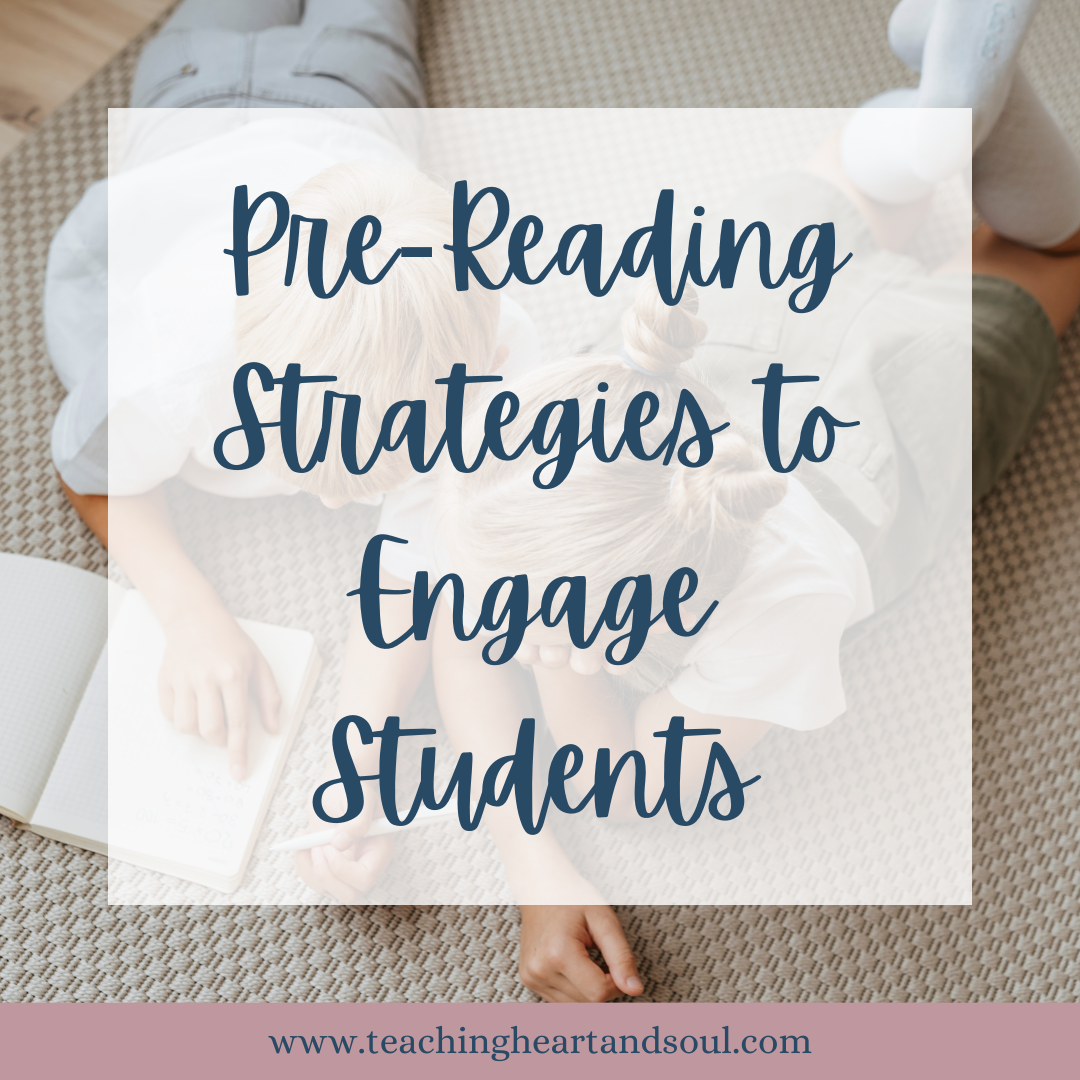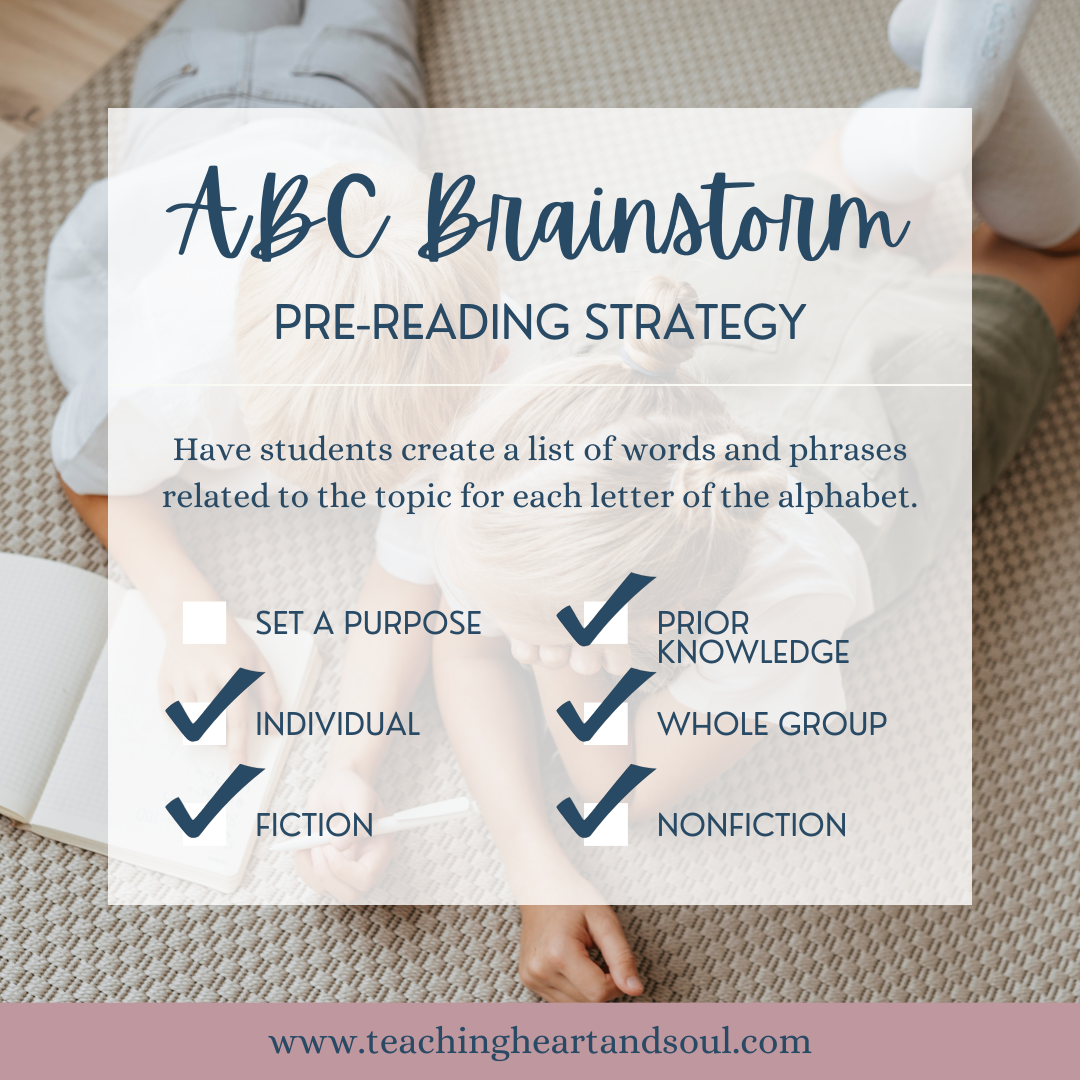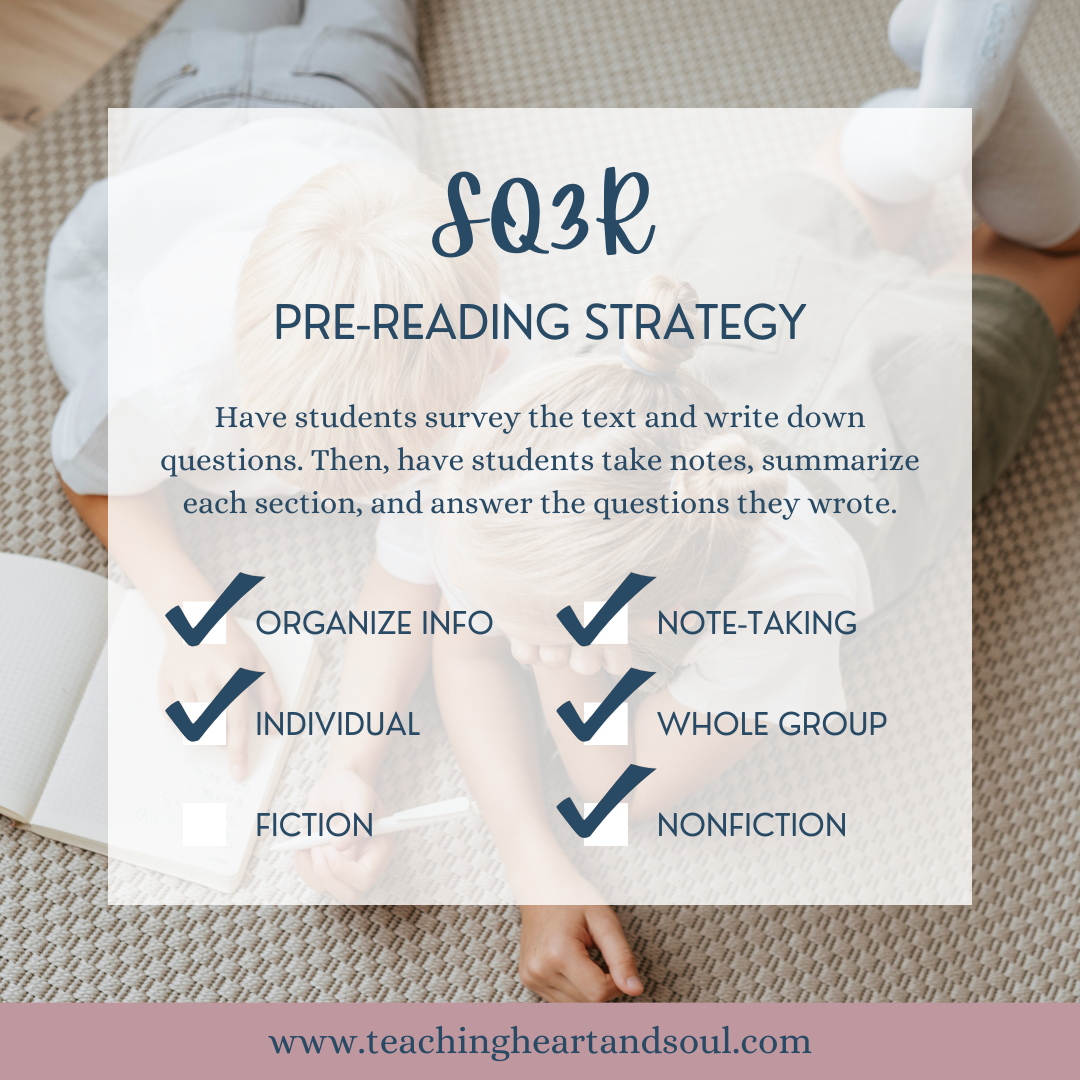Important Pre-Reading Strategies to Engage and Prepare Students
The pre-reading phase lays a foundation for reading comprehension.
Pre-reading strategies encompass a variety of techniques, from building background knowledge to increasing vocabulary. These strategies bridge the gap for many students, including English language learners and struggling readers.
Through pre-reading activities, students embark on the reading adventure with a sense of purpose and preparedness.
Click HERE if you're looking for printable resources to facilitate these pre-reading strategies.
Build Background Knowledge
One of the benefits of many pre-reading activities is that they activate background knowledge to prepare students for a particular text.
Prior knowledge gives students a conceptual framework from which to build.
A passage or book may discuss many topics - historical fiction might talk about world events or geography, narratives may reference Greek mythology - and having the background information needed to understand these new topics is important.
Readers must remember what they already know to contextualize the new information in a particular text or they must learn the background information necessary. Explicitly activating prior knowledge and building background information helps learners understand a text. It allows them to integrate the new information with what they already know.
Reading Comprehension and Engagement
Pre-reading strategies pave the way for effective comprehension and engagement.
English language learners, struggling readers, and other learners can better navigate the reading process through pre-reading strategies.
Having a graphic organizer to visualize the information helps students with comprehension because graphic organizers help arrange the information and integrate it with what readers already know.
It can be difficult for a reader to differentiate between details and a more general understanding of a topic. However, many pre-reading strategies help students discern between the big picture and key details.
There is a variety of good free content that you can use to support reading comprehension. Check out my resource HERE that includes 50 pages of reading comprehension and vocabulary resources.
Vocabulary and Word Work
In addition to focusing on prior knowledge, pre-reading strategies should also prepare students for the unfamiliar vocabulary of a new topic. Therefore, it is important to teach the words needed to understand a particular topic.
Many pre-reading activities help readers learn a word or two that they might not understand before they begin reading.
Set a Purpose
Finally, pre-reading activities help teachers set a purpose for reading so that their classroom of students stays on task and knows what information to look for as they're reading.
A story or picture book may have a theme to look for.
A nonfiction text may have specific information that the class needs to know.
Whatever the case may be, setting the purpose ahead of time through simple discussion questions, making predictions, writing out a KWL chart, or other strategies is a huge benefit.
Pre-Reading Activities
Below are pre-reading activities you can do to motivate students in your classroom to engage in and understand their reading. Many of these activities could be done independently, as a whole group, or in two or three groups that are smaller.
Click HERE for worksheets to go along with these strategies.
ABC Brainstorm
ABC Brainstorm provides an opportunity for students to activate their background knowledge. This is a great independent activity that students can complete while you finish preparing to read the text.
For the ABC Brainstorm activity, have students think about the topic of the day's lesson by trying to come up with at least one word or phrase that is connected with the topic of the lesson for each letter of the alphabet. You could even turn this into a competition and have students earn points for each word or phrase they come up with.
Anticipation Guides
Anticipation guides can also help activate students' background knowledge. It can also establish a purpose for reading because students will be looking for evidence that either confirms or challenges them to reconsider certain views.
Implementation:
To facilitate anticipation guides, write several statements (5-10) that focus on some key ideas from the text. These should be agree/disagree statements that students can respond to without reading the text.
Have students complete one column of the anticipation guide prior to reading the text. Then, have a quick discussion (whole class, partners, etc.) about the statements before reading the text.
Next, have students read the text, while considering the statements from the anticipation guide.
After students have finished reading, have them complete the other column of the anticipation guide.
Have students discuss what they learned, concentrating on any statements that they changed their minds about.
Anticipatory Set
An anticipatory set grabs students' attention, creates relevance, and prepares their minds for the upcoming reading. It activates prior knowledge and sets the purpose for reading.
For this strategy, start the lesson with a thought-provoking question related to the text. For example, if you're reading a text about the seasons, you can ask students what their favorite season is and why. Encourage students to briefly discuss or write down their thoughts.
This is a great opportunity to use think-pair-share to process the question.
Background Research
Background research helps students build context and familiarity with the topic. This pre-reading research helps students connect with the material before diving into the text, fostering better comprehension and discussions.
Implementation:
Before the reading assignment, assign students to conduct a brief online research session on the topic.
Provide a list of reliable educational websites or a short video relating to the subject.
Instruct students to watch a short video or read a summarized article.
They should jot down key points, interesting facts, or questions.
Comparisons
Making comparisons between new topics and information your class already knows is a great way to activate prior knowledge and connect it with the new learning. It builds a framework from which to understand the new topic.
For example, to help students better understand habitats, have them compare an animal's habitat to their own living environment. Then, getting more specific, a shelter like a cave could be compared to a person's home and hunting could be compared to grocery shopping.
Creative Activities
Creative activities tap into students' interests, which strengthens engagement.
Choose a creative activity that aligns with the reading material.
For instance, if the text is about a historical event, have students write a short dialogue between historical figures, create a visual timeline, or even enact a brief role-play. If the topic is a scientific concept, ask students to draw a diagram or create a poster explaining the concept.
Encourage students to connect their creative work to the upcoming reading, discussing how their project relates to the material. This strategy builds curiosity, establishes context, and enhances comprehension.
Knowledge Rating
Knowledge rating helps students take ownership of their learning, activates prior knowledge, and helps to set a purpose.
Implementation:
For this activity, write a few concepts down on a piece of paper.
Before reading, have students indicate how well they understand that concept by putting down a rating, such as filling in stars.
After reading, have students rate their understanding again and see how much they learned.
KWL (Know-Want-Learn)
KWL is a popular pre-reading activity. Students can create a KWL chart for themselves, or you can complete this activity as a whole class.
KWL, or Know-Want-Learn, helps students organize their prior knowledge, questions, and learning. This strategy is not just a pre-reading strategy, but can be used throughout the reading process.
Implementation:
For KWL, create three columns on a piece of anchor chart paper, your white board, or piece of paper, and label them "K" (What students KNOW), "W" (What students WANT to learn), and "L" (What students have LEARNED).
Before reading, fill out the first column with information your students already know about the topic. Then, have your students generate questions they have about the topic in the second column.
During reading, have your students look for the answers to the questions they have.
After reading, have students write down the new things they learned in the last column.
Opinion Evidence
Opinion evidence is a great way to activate prior knowledge and set a purpose for reading. It is also a great way to practice note-taking skills.
Implementation:
To facilitate opinion evidence, have each student write 3-5 opinions they have about the topic you will be reading about.
Then, as they read, have them take notes about each opinion.
After they finish reading, they can choose to revise their opinion based on text evidence or maintain their opinion.
Pre-Reading Questions
Pre-reading questions guide students' focus during the reading, encouraging them to look for certain information. Consequently, it helps with comprehension and note-taking skills.
Implementation:
Prepare 3-5 questions related to the reading material. These questions should focus on the concepts and details you most want your students to take away from the reading.
Hand these questions out to students before reading and go over each question.
Then, during reading, have your students look for the answers to these questions and take notes.
Afterward, have students answer questions using the notes they took.
Skim & Scan
Skim & Scan helps students understand the organization, main ideas, and key elements of the text, which makes it easier to navigate and comprehend. Through this activity, students can make predictions and ask questions, which helps create buy-in and directs their focus.
Implementation:
To start, have students skim and scan the front cover, back cover, table of contents, headings, subheadings, images, and bolded words which show key words.
Students should then use this information to make predictions and ask questions that they can't answer through the text features.
After making predictions, students will pay more attention to the text to see if their predictions were right.
They will also be interested in finding the answers to the questions they asked. This helps support critical thinking of the text. Being able to confirm or revise their predictions also helps students practice active monitoring of their own comprehension.
Click HERE for low-prep worksheets to go along with these strategies.
Speed Chatting
Speed chatting helps with student engagement and activating prior knowledge.
Implementation:
To facilitate speed chatting, prepare a couple simple questions related to the topic of the text.
Then, have students make two rows facing each other.
Students will discuss the answer to the first question with their partner.
Then, they will rotate and discuss the next question with a new partner.
SQ3R
The SQ3R strategy encourages critical thinking as students generate questions, summarize information, and refine their knowledge through review. Through surveying, questioning, reading, reciting, and reviewing, students actively interact with the material, fostering a deeper understanding of key concepts and details.
Implementation:
Survey: Begin by quickly surveying the entire text, including headings, subheadings, illustrations, and any highlighted or bolded text. This step provides an overview of the material and helps you get a sense of its structure and main ideas.
Question: Formulate questions based on the headings and subheadings you've surveyed. This step helps you become actively engaged with the text and provides a purpose for reading. The questions guide your reading and help you seek specific information.
Read: Read the text thoroughly while keeping your questions in mind. Pay attention to key points, supporting details, and any information that answers your questions. Take notes as you read, focusing on capturing main ideas and relevant details.
Recite: After reading a section or a chapter, pause and recite or summarize the key points and answers to your questions. This step reinforces your understanding and helps you process the information.
Review: Once you've finished reading the entire text, review your notes and summaries. Revisit your questions and answers to ensure you've captured the essential information. This final review helps consolidate your learning and improve long-term retention.
Think-Aloud
Think-alouds provide insight into the thinking process involved in reading. This helps them understand how to approach the text, make connections, and make predictions, ultimately enhancing their comprehension skills.
Implementation:
Choose a short passage related to the upcoming reading.
Read the passage aloud while verbalizing your thoughts.
Explain how you're making connections to prior knowledge, predicting what might happen next, and identifying key points.
Highlight the thought process that skilled readers engage in.
After the think-aloud, discuss it with the students, emphasizing the importance of active engagement with the text. Encourage students to practice think-alouds with their own reading assignments.
Visual Aids
Visual aids offer context, activate prior knowledge, and make abstract concepts more concrete, leading to better comprehension and engagement.
To use this strategy, gather or create relevant visual aids (pictures, diagrams, maps) related to the reading material. (You can also use the images from the text.) Display the visual aids to the students before introducing the text.
For example, if the reading is about the water cycle, show a diagram illustrating the cycle. Ask students to observe the visual aid and make predictions about the topic. Use these predictions to generate interest and set the stage for the reading.
Webbing
Webbing helps students activate prior knowledge and organize information about a topic. This is a great option to help students assimilate their new learning with what they already know about the topic.
Implementation:
For webbing, give students the topic you will be learning about.
Then, have students write a list of the information they already know about that topic.
During reading, have students add to this list with the new information they learned and correct any misinformation.
After reading, have students organize this information into a web to better understand the relationships between topics.
Word Exploration
To help students understand difficult vocabulary in a text, try Word Exploration.
Implementation:
For this before-reading strategy, each student will skim through the text and write down words that they are unfamiliar with.
Then, students will look up the definition to those words and write them down as a reference sheet for reading.
This can be done at an individual level or as a whole class.
Conclusion
Teachers will do well to bring pre-reading activities to their school. Pre-reading strategies play a vital role in preparing students for successful reading experiences. By activating prior knowledge and building connections, these strategies pave the way for better understanding of new information. They empower students to approach texts with purpose, enhance comprehension, and foster a deeper engagement with the material.
Click HERE if you'd like to download the printable worksheets and graphic organizers to go along with this list of activities for the pre-reading stage.
You can also purchase the bundle of over 30 pre-reading, during-reading, and post-reading strategies HERE.
Further Reading
Click HERE for effective reading comprehension questions to use with your students.
Click HERE to learn about the benefits of reading aloud to your students.
Click HERE to find reading comprehension activities for your classroom.




